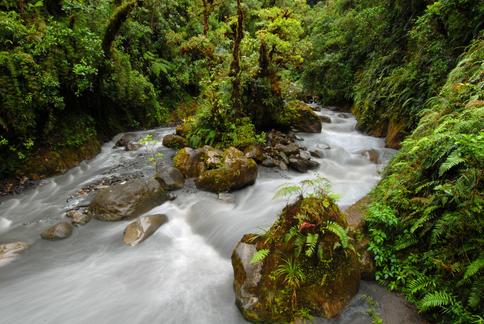
Forests are our greatest natural ally in the fight against climate change, yet in many places they are more valuable dead than alive.
Conservation International is working to flip the script by valuing the carbon that trees remove from the atmosphere and store in their trunks and soils. Through carbon projects, we help to protect the climate by protecting forests — and the people who depend on them. As one solution to the climate crisis, forest-carbon projects are helping humanity bend the climate curve.
11%
of greenhouse-gas emissions
Deforestation accounts for 11 percent of human-caused greenhouse-gas emissions.
30%
of emissions reductions
Protecting and restoring forests represents at least 30 percent of the necessary emissions reductions to avoid climate catastrophe.
3%
of funding
Yet these “natural climate solutions” receive only 3 percent of global finance dedicated to protecting the climate.
25%
of people
Approximately 25 percent of people on Earth depend directly on forest resources for their livelihoods.
What is a carbon credit?
A carbon credit represents a reduction of 1 metric ton in greenhouse gas emissions to compensate for 1 metric ton of emissions made somewhere else. A credit can be bought, sold or traded before it is “retired,” meaning it cannot be traded again, assuring that only the buyer can claim emissions cuts associated with that credit.
What carbon credits are not:
- A license to pollute: Carbon credits are a “bridge” for emitters working to reduce their emissions, not a pass for business as usual. In fact, companies that invest in nature-based credits are leaders, not laggards: Three recent studies found that companies that bought voluntary carbon credits did more across the board to cut emissions than companies that did not.
- A silver bullet: Carbon projects alone will not solve climate change — they are a vital way to flatten the carbon curve while the world transitions away from fossil fuels.
- Doomed by technical challenges: Carbon projects have been implemented in various forms for more than two decades, passing from the experimental to the commonplace thanks to testing and scientific advancements. science and technology have advanced to ensure that carbon projects are having their intended benefits.
- A ‘land grab’: High-quality carbon projects are necessarily built on the free, prior and informed consent of local communities in the project area. These projects do not separate people from their lands, but rather are predicated upon strengthening and upholding their rights to their lands.
What is a ‘carbon project’?
The idea behind a forest carbon project: pay people to not cut down their forests and restore ecosystems through the sale of “carbon credits.” Governments, companies and individuals can buy and trade credits to supplement the cuts made to their emissions, with revenue going to local communities as an incentive to keep forests standing or restore them. The result: Credit buyers compensate for a portion of their carbon footprint, and forests survive to absorb climate-warming carbon from the atmosphere while supporting local communities.
What are the benefits of carbon projects?

Wildlife
Forests are home to countless species that exist nowhere else — including many plant species that are critical to medicine, and pollinators crucial for agriculture.

Water
Forests are powerhouses of the water cycle, contributing to rainfall, holding and filtering water — and providing flood control — for adjacent communities.

Food and jobs
Millions depend directly on the goods and services that forests provide, including those related to clean water, food security and jobs.

Sustainable development
Revenue from carbon projects funds social, educational and health programs in forest communities, and support sustainable and economically resilient jobs for millions.
Requirements for carbon projects
To be considered high-quality and successful, carbon projects must meet stringent criteria, including:
- Additionality: Emissions cuts would not have occurred without the carbon project investment.
- Permanence: Emissions reductions or removals represented by a carbon credit must endure for the long term.
- Leakage: Deforestation is not simply displaced from one area to another.
- Benefit-sharing: Beneficiary communities of carbon projects are equitably compensated.
How these requirements are being met
All forest carbon credits traded internationally are guided by United Nations requirements, including:
- Baseline: A baseline against which deforestation, degradation, conservation and restoration are measured to ensure that emissions are being reduced or removed
- Monitoring: A monitoring system to measure forest-cover changes against the baseline to ensure additionality
- Strategy: A national strategy to ensure permanence and avoid leakage
- Safeguards: Adherence to social safeguards to ensure respect for Indigenous rights and the participation of local stakeholders, as well as environmental safeguards to mitigate the risk of forest loss
What is ‘REDD+?’
Some carbon projects are designed under a framework called REDD+ —Reducing Emissions from Deforestation and forest Degradation — a UN-backed policy and incentives framework that enables countries to protect forests to achieve the emissions cuts required by the UN and the Paris Agreement.
Principles for Investments in Natural Climate Solutions
Nature is one of the most effective tools to stop climate breakdown, yet natural climate solutions receive less than 3 percent of all global climate funding. Conservation International’s Principles for Investments in Natural Climate Solutions guide our engagement with companies that are helping to protect ecosystems that store climate-warming carbon and keep it from the atmosphere.